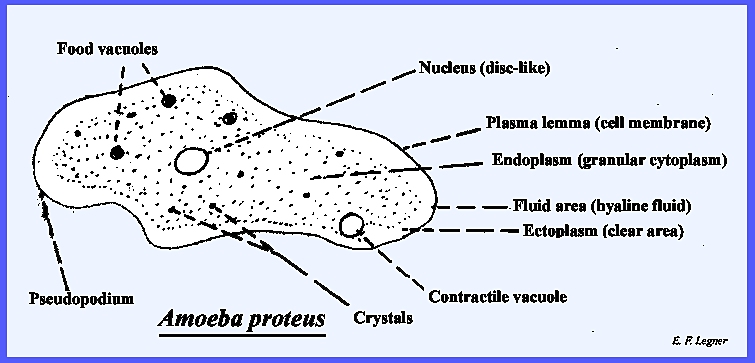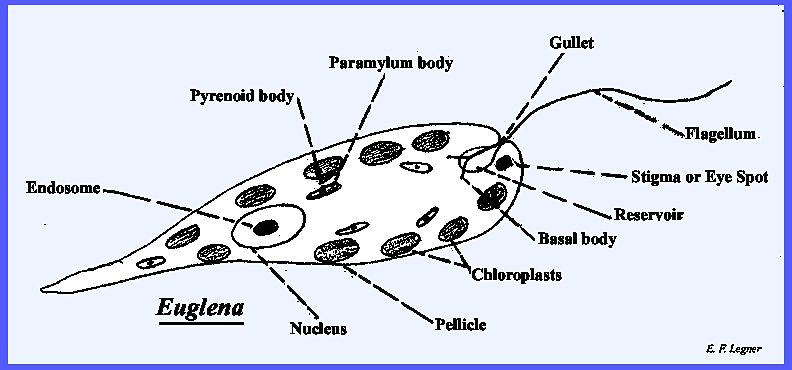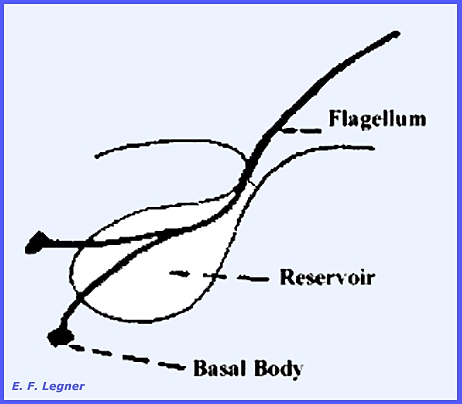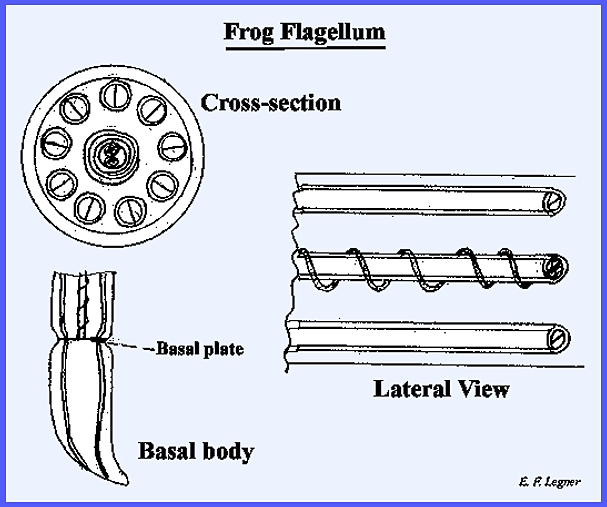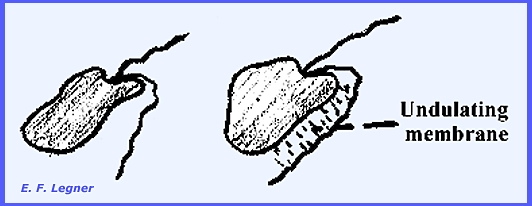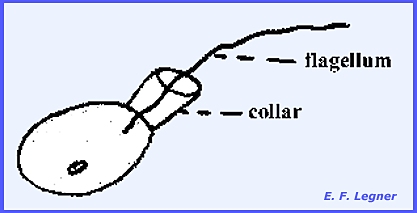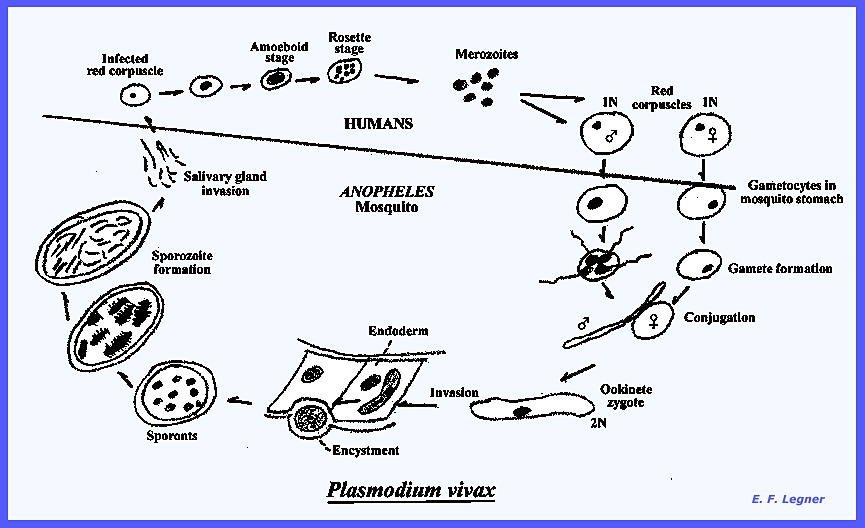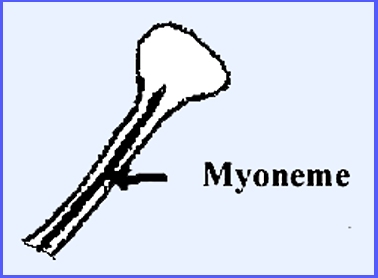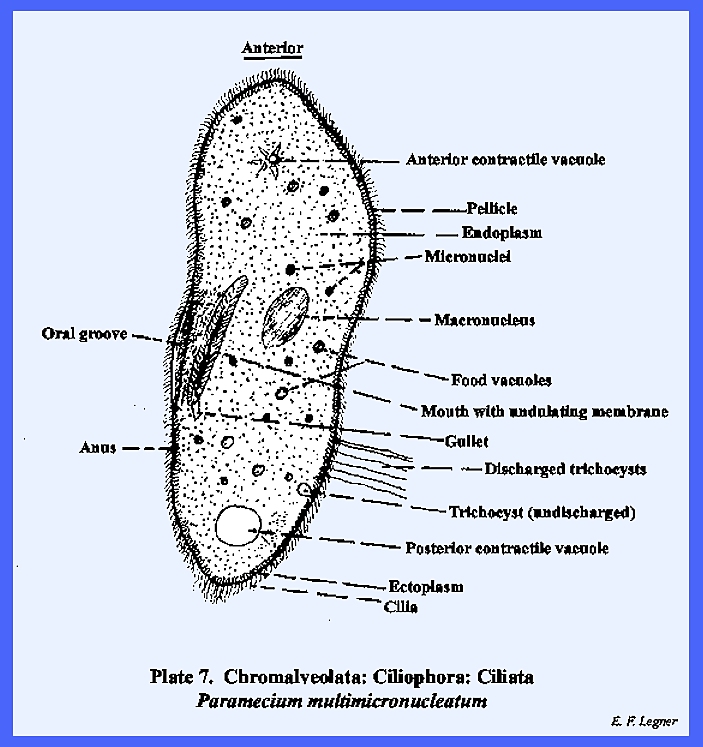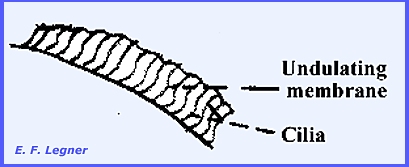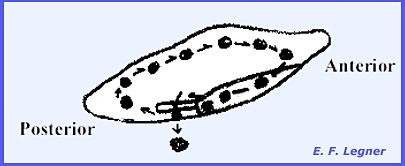File:
<inverteb.htm> <Index to Invertebrates> <Bibliography> <Glossary> Site Description <Navigate to
Home>
Animalia►
Invertebrate Zoology
Kingdoms: Protista, Chromalyeolata & Animalia
(Contact) CONTENTS
CLICK on underlined file names &
illustrations for details:
Invertebrate zoology is a
biological discipline that involves the study of invertebrates. Although vertebrates possess many
characters in common with invertebrates they are distinguished by possessing
a backbone. Invertebrates lack a backbone. Invertebrates comprise over 95 percent of
all animal species and certainly more than that percentage in animal
biomass. They have been extensively
used in biological researches of heredity, embryology and regeneration. They also have had great practical
importance related to insect damage, the causes of human and animal disease
and directly as food, pearls, buttons, etc. As we proceed to examine the
various characteristics of the different animals it becomes obvious that a
common bond unites all animals in that we must all respire, consume food,
excrete wastes and reproduce. Zoology may also be divided
further into other principal categories such as: Arthropodology
= The study of arthropods, including Arachnology (spiders & mites),
Entomology (insects) and Carcinology (crustaceans). Malacology = The study of
mollusks. Invertebrate
Paleontology = The study of extinct
invertebrates. For a classification
of Invertebrates as treated herein please see Table 1. However, the principal groups may also be
noted as follows:
Arthropoda -- insects, arachnids, crustaceans Nematoda -- round
worms Mollusca --
squid, snails, bivalves Annelida --
segmented worms (earthworms, leeches, polychaetes) Nemertinea --
ribbon worms Platyhelminthes
-- flat worms
Acoelomorpha (controversial phylum: probably Platyhelminthes) Rotifera -- wheel
animals Ctenophora -- Comb jellies Cnidaria -- jellyfishes, corals, sea
anemones, hydras Porifera -- sponges Echinodermata - starfishes, sea urchin The arrangement of the
various subgroups is based on ever increasing complexity and presumed evolution
of the most primitive [(e.g., Protista (Protozoa)] to the more advanced
organisms. Previous names of groups
are included in parentheses. There
continues to be wide disagreement on classification, and although further
rearrangements are expected as more biological and biochemical data are
forthcoming, the presented design should enable identification of major
orders, families and genera. The Protista (Protozoa) are included herein as a
primitive precursor group. Emphasis
has been placed on morphological and behavioral characteristics that are
easily discernable, and a simple diagrammatic style suitable for lecturing is
used for most of the illustrations. A binocular microscope with a 20X
magnification is advisable for those wishing to view living and preserved
specimens. Greater detail on a
particular group or species may be found by referring to publications listed
in the Bibliography
or through Internet searches. This is a self-contained database
with a minimum of links outside its limits.
Independent Internet searches are encouraged for greater detail on a
particular animal group. --------------------------------------- Kingdom:
PROTISTA (Protozoa) -- unicellular microbes, plankton Phylum: Sarcomastigophora ,
Class: Rhizopoda (Sarcodina) [Mycetozoa have been included in the Myxomycetes or Amoebozoa
of Mycology] The above differ also in their
nuclear content. Foraminifer and
Radiolara use asexual reproduction.
Flagella also occur in the Sarcodina.
There are many that form symbiosis with algae. For example, Zoochlorellae are Heliozoa
with green algae; Zooxanthellae are Radiolaria with yellow algae. Their importance ranks high. Endomoeba histolytica
is a notorious intestinal parasite and they serve as an important link in the
food chain. The Protista that have been called
Protozoa, or "First Animals"
are more like the early primitive animals than any other living forms. They have changed less than other
groups. They are usually
single-celled animals that may exit in a colony. But each individual cell retains its independence. Their simplicity is often deceiving. Amoebe, for instance, do all the basic
functions as humans. However, the cells
of Protozoa are so complex that they have frequently been regarded as
"acellular." There are all
grades of cellular differentiation from very primitive as in amoeba and
advanced as in the higher ciliates and flagellates. There are definite openings for the taking of food
developed. Locomotor structures
appear and contractile structures show up, which function as muscle
fibers. The bases of the cilia and
flagellae are connected. Different
grades of reproduction occur from binary fission, complete sexual
differentiation and an alternation of sexual generations. Protista have reached the point of
multicellular organization.
Flagellates are shown to be the most developed and it is believed that
they resemble the original stock group that gave rise to both plants and
animals. At one time all Protista
were believed to have evolved from the flagellates. The Class Rhizopoda (Sarcodina)
is characterized by pseudopodia, which are organelles that are not true
organs. They serve in locomotion and
food getting. The cytoplasm of the
cell is not provided with many visible structures that possess specific
functions. Amoeba
proteus
is a common fresh water
rhizopod that occurs in calm, semi-stagnant water. It is microscopic in size and its form is indefinite. Ingestion &
Digestion of Food.-- The cytoplasm of
A.
proteus consists of two
parts: (1) a plasmagel that
includes a clear layer and an outer portion of endoplasm, and (2) a plasmasol,
which is a fluid or the inner endoplasm.
The organism is holozoic, taking in
solid food consisting of algae (diatoms) and other protozoa into its
body. The food is captured by the pseudopodia,
and a food cup is formed that engulfs the food bringing it inside in a food
vacuole. Another means of feeding
occurs where the food slips past the cell membrane and thereby enters the
cell. There is no vacuole formed in
this type. Digestive enzymes diffuse
into the vacuole and dissolve the food.
Indigestible portions are left in the vacuole. Protein and carbohydrate enzymes are
present in abundance, but there are few fat enzymes. Egestion is accomplished by the vacuole
migrating to the edge of the amoeba and eventually becoming located on the
outside of the organism. Amoeboid Movement.-- The
plasmagel and plasmasol are interchangeable, the former holding the latter
under some pressure. When the
plasmagel weakens or converts to plasmasol anywhere on the animal, the
pressure forces the plasmasol out into a pseudopodium. The plasmasol sets into a gel all along
the edges of the pseudopodium in the form of a tube. The posterior end of the cell then
crumples up while converting plasmagel to plasmasol so as to form the new
extension. Circulation is accomplished by
movements of the animal itself, and respiration and
excretion
are simple diffusions
through the cell membrane. The Contractile
Vacuole
is usually located at
the posterior end of the amoeba. This
is a water regulating mechanism that pumps out water that moves into the cell
by osmosis. There is an incidental
expulsion of water products. With an
increase in the salt concentration of the medium the contractile vacuole
slows down and finally stops. A
reduction of salt concentration results in a reactivation of the vacuole. Support & Protection.--
There is little support needed in a suspended animal like Amoeba,
and there are no protective mechanisms.
However, when unfavorable environmental conditions occur Amoeba
forms a cyst that can resist drying, temperature extremes, etc. Sensitivity & Conduction.--
Amoeba
behaves as if it had a nervous system, which it does not. A stimulus applied at one point on the
animal body may cause any other portion to react. The animal perceives and responds to environmental
changes. There is a positive response
to food and weak light, and a negative response to all other stimuli. It generally responds in some way to
light, temperature, touch and chemical reactions. There are no visible sensory or motor apparatus in the
cytoplasm, but Amoeba is regarded as being generally sensitive. Reproduction is
entirely asexual being effected by binary fission (cell division). Size determines when A. proteus will
reproduce, which is usually 150 microns.
Sexual processes doe occur within the class but not in this
genus. ------------------------------------ In
the Phylum
Sarcomastigophora
Class Mastigophora (Flagellata) movement
is primarily by means of a flagellum.
Amoeboid stages may occur in some phase of the life cycle,
however. But adults always move by
the flagellum. When parasitic they do
not form spores. Nutrition is
holozoic, saprophytic or parasitic.
The Subclass Phytomastigina include green flagellates while
Zoomastigina are the colorless flagellates. The Phytomastigina includes the genus Euglena. These animals occur primarily in
fresh water and an abundance of them may produce a green scum. Their size varies from 25-500 microns and
the body wall is more rigid than that of the amoebae. There is a rigid, grooved wall or pellicle
present, however the ecto- and endoplasm are not well defined. Nutrition is holophytic
where the animal manufactures it own food by
photosynthesis. But in darkness it will
live on dissolved nutrient material and thus is saprophytic. Food is stored in paramylum
bodies, and pyrenoid
bodies
occur in the center of
the chloroplasts, which serve to regulate them. In darkness chlorophyll disappears from the cell. Circulation, excretion and respiration are
the same as in Amoeba
proteus. Contractile vacuoles are located
around the reservoir whose function is to serves as exit to the
vacuoles. Locomotion is by movements
of the flagellum. The flagellum has a
central core and is spirally wound with cytoplasm. The flagellum separates into two extension in the reservoir and
terminates in basal bodies. As for sensitivity, there is an
eyespot, which is positive to weak or moderate light but negative to strong
light or arkness. Conduction is like Amoeba. The basal bodies serve as a coordinating
mechanism because their removal discoordinates the flagellum. Reproduction is asexual with longitudinal
binary fission. All parts are
regenerative and there is no sexual reproduction in Euglena
although others of the class do show it.
Cyst formation occurs to withstand adverse environmental conditions. Some species in the Phytomastigina order Dinoflagellata
have an armor plate (cellulose armor)
that is occasionally shed and replaced.
The order is a large group of importance in marine habitats as
plankton. Dinoflagellates produce the
"Red
Tide" in oceans that
results in widespread fish kills. The flagella have been termed
"Frog Flagella" that are
diagrammed as follows: In the Subclass Zoomastigina nutrition is holozoic,
saprophytic and parasitic. The
animals are colorless. The flagella
are very numerous and their arrangement is anterior with one flagellum
extended anteriorly and the other trailing.
They may be fastened to the side of the organism by an undulating
membrane. Several genera of the Zoomastigina
are of great importance to humans and animals because of their parasitic
habits. Trypanosoma causes
"African Sleeping Sickness",
Trichomonas
is a parasite of humans
and animals, Leishmania
causes a skin disease
known as "Oriental Sore,"
and Giardia
is a severe human
intestinal parasite. Also of
importance is that species may also produce oils instead of paramylum, which
results in foul-smelling and foul-tasting water. On the other hand, termites possess
a Zoomastigina symbiont that is of mutual benefit. Phytomastigina have a well-developed
and pronounced colonial arrangement, which is true also of the Zoomastigina
but not as pronounced. The
Phytomastigina genus Pandorina has
16-32 cells while Volvox has hundreds of
cells in a gelatinous matrix. Any
division of labor limits the boundary between colonial organisms and
multicellular organisms. Volvox
may be sometimes regarded as multicellular, but reproductive cells in Volvox
function only to reproduce the organism.
Species in the order Protomonadina possess
a funnel-shaped collar similar to cells that are found in the Porifera. Sexual reproduction in the Phytomastigina is especially
prevalent. Isogametes of identical
appearance and behavior are formed or heterogametes may be the case as in Volvox. ------------------------------------ All members of the Phylum: Apicomplexa (Sporozoa) are parasitic, and all produce spores at
some stage. There are no locomotory
organelles in the mature stage, although the immature forms may possess
them. Life cycles vary from simple to
complex.
The incitant of malaria, Plasmodium
vivax,
has one of the most complicated life cycles.
There are alternates of sexual with asexual reproduction. Malaria is considered to be one of the
most important diseases of humans and it also affects animals
extensively. Its life cycle is as
follows:
Other important diseases found in the Apicomplexa are Texas Cattle Fever, Nosema (affecting honeybees and silkworms) and Coccidiosis (in chickens). ------------------------------------ Please see
following plates for Example Structures of the Protista: Plate 65 = Kingdom: Protista -- Development
characteristics Plate 1 = Different body shapes in Rotifera. Plate
2 = Protista: Sarcomastigophora: Rhizopoda: Amoebina: Amoeba proteus Plate
3 = Protista: Sarcomastigophora: Rhizopoda: Foraminifera &
Radiolaria Plate
4 = Protista: Mastigophora: Eglenoidea: Euglena viridis Plate
5 = Protista: Mastigophora: Phytomastigina: Volvocina: Volvox
globator Plate 6 = Protista: Sarcomastigophora:
Mastigophora & Apicomplexa (Pandorina sp., Trichonympha sp., Trypanosoma
rhodesieusi & Plasmodium vivax ------------------------------------ The Kingdom: CHROMALYEOLATA (Infusoria) Included here are the ciliates and
water
molds. Members possess cilia as locomotory
organelles. There are two kinds of
nuclei present in some members (1) micronuclei and (2) macronuclei). Reproduction is by conjugation. This section will discuss the Superphylum: Alveolata Phylum: Ciliophora. In the Class Ciliata there
are two subclasses: Protociliata and
Euciliata. The Protociliata
(e.g., Opalina) is a very small group
all members of which are parasites or commensals. There are neither macro- nor micronuclei but rather the nuclei
are scattered and all of the same size.
There is no conjugation and the group may be transferred to the
Mastigophora. The Euciliata are the
true ciliates where macro- and micronuclei and conjugation are present. Cilia are common in many of the
Ciliata and an undulating membrane occurs in Paramecium's gullet. Membranelle exist that generally surround
the food-gathering portion of the body.
These are paddle-like and my also function in locomotion. Vorticella is a representative
genus. Cirri or
leg-like tuft cilia are present in Euplotes which are fused cilia that look
and act like legs. These have been
called "crawling cilia." Nutrition is mostly holozoic and
many are saprozooic, living off the dissolved organic matter that is taken in
through the body wall. Some species
are also parasitic. Contractile structures or myonemes are
present, which serve as muscle cells.
Such are found in the stalk of Vorticella. Some species of ciliates occur in
the digestive tract of animals and actually assist in cellulose
digestion. Balantidium
coli is present in humans. ------------------------------------ Paramecium
is a representative
genus in the Euciliata that occurs wherever
bacteria are present. They are
slipper-shaped with a lateral grove called the "Oral
Groove." These organisms are uniformly clothed with
cilia and the body surface has a pellicle.
One large macronucleus and
a small micronucleus
are present. There are two contractile vacuoles at
opposite ends each of which operates alternately with the other. A plasmagel and plasmasol are easily
distinguishable and the average length is 200 microns. Feeding.--
Bacteria are the principal food of Paramecium. Feeding involves cilia that beat a current
of food into the oral groove and finally into the gullet. A modified group of cilia occur in the
gullet to form the undulating membrane. At the base of the gullet there is
a food vacuole, which detaches like a bubble when it is full and then moves
throughout the body in a well-defined path.
The path of movement is first posterior, then anterior, and finally
posterior with termination in the anus. There is a constant circulation of
plasmasol, which causes the food vacuoles to be carried around a cyclosis. The food vacuole is acid at first and
later becomes alkaline. Circulation.--
This is accomplished by cyclosis,
and simple diffusion takes care of excretion and gas exchange. Locomotion.--
The waving of cilia accomplishes locomotion.
These resemble short, blunt flagella but they differ by their shorter
length and numbers. Each cilium terminates
proximally in a basal body that is interconnected with all basal bodies in
the organism. Support
is given by the pellicle. Protection
is furnished by trichocysts, which
simply serve as anchors while the cilia re waving food into the gullet. There is no cyst formation in Paramecium, the animal being
hearty and can withstand extremes in oxygen and carbon-dioxide
concentrations. Sensitivity.--
Paramecium
is indifferent to light except for one species that has a green alga
symbiont. Actually all the cilia may
be sensory and able to discriminate between edible and nonedible substances. Coordination.--
There is coordination between the many cilia and may be brought about by the
interconnections of their basal bodies.
The presence of an "amotorium"
or kind of central brain is obscure. Reproduction.--
Paramecium
reproduces by binary fission. Conjugation is like that found in
Ciliata and Suctoria. It occurs only
in individuals with a macro- and micronucleus. Two conjugating individuals become sticky and pair. The micronucleus is involved in genetic
transfer. Step I
= The micronucleus divides. Step II
= A second division occurs (--4 haploid micronuclei in each conjugant) Step III
= Three micronuclei degenerate; the one remaining divides again. Step
IV = There is a mutual
exchange of micronuclei (one goes to mate and one remains behind) Step V
= There is a fusion of two haploid micronuclei
to form one diploid micronucleus. Step
VI =
The cells separate from one another and are termed "exconjugants." The
macronucleus disintegrates. Post
Conjugation in Paramecium Step I =
2N micronucleus divides to produce eight 2N micronuclei. Step
II = Four micronuclei
enlarge to form macronuclei, while four micronuclei remain unchanged. Step
III =
The cell divides to produce four cells, each of which possesses one
micronucleus and one macronucleus. Step IV = The macronuclei then grow enormously by forming the
polyploid condition. They apparently
regulate all the vegetative processes in the cytoplasm. In asexual reproduction the micronucleus
always divides by mitosis while the macronucleus divides by splitting almost
in half. ------------------------------------
The Class: Phyllopharyngea, Subclass: Suctoria has
cilia in immature stages and adults possess tentacles. They paralyze their prey and the suctorial
tentacles
suck the prey dry. Macro- and micronuclei and
conjugation are present. Adults are
sessile and the group occurs in both fresh and salt water. Many are free living, some are commensals
and a few are parasites. They have
little economic significance. ------------------------------------ Please see
following plates for Example Structures of the Chromalveolata: Plate
7 = Chromalveolata: Ciliophora: Ciliata: Paramecium
multimicronucleatum Plate 8 = Chromalveolata: Ciliophora:
Ciliata: Nyclotherus sp., Opalina sp., Didinium nasutum
& Paramecium sp. Plate
9 = Chromalveolata: Ciliophora: Ciliata & Phyllopharyngea (Euplotes
patella & Ephelota sp.) Plate 66 = Kingdom: Chromalyeolata, Phylum:
Ciliata -- Paramecium structure ============== |
